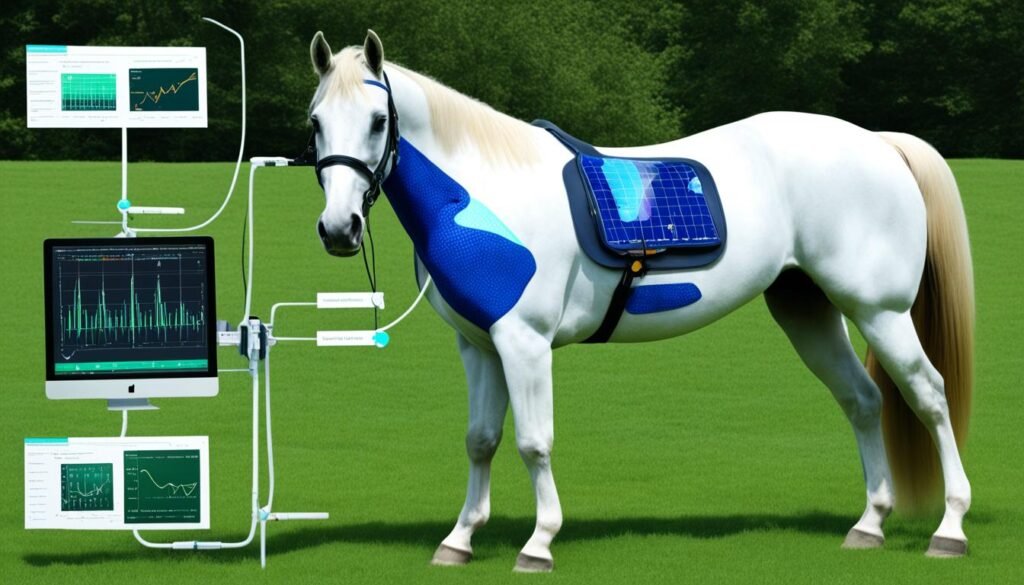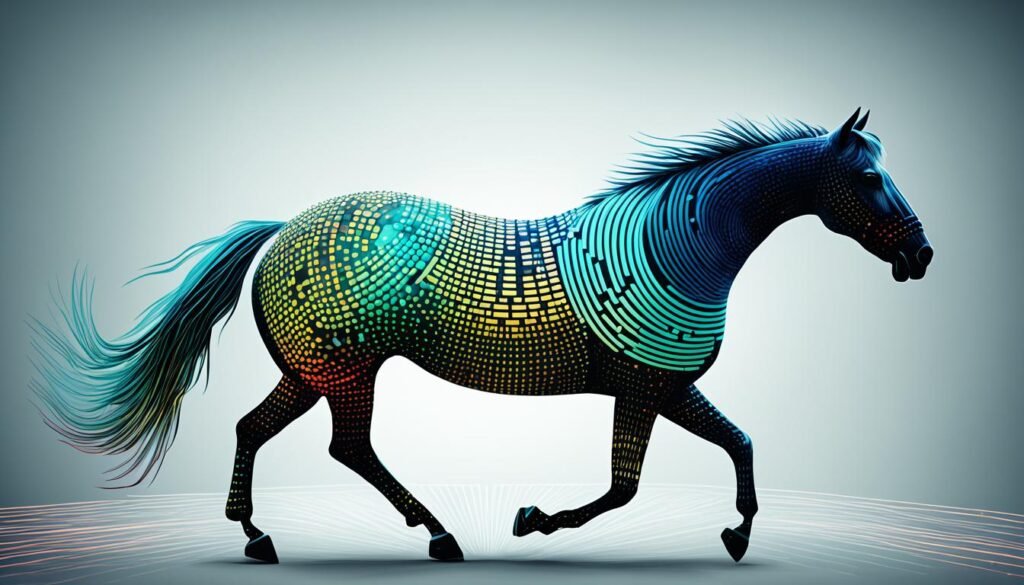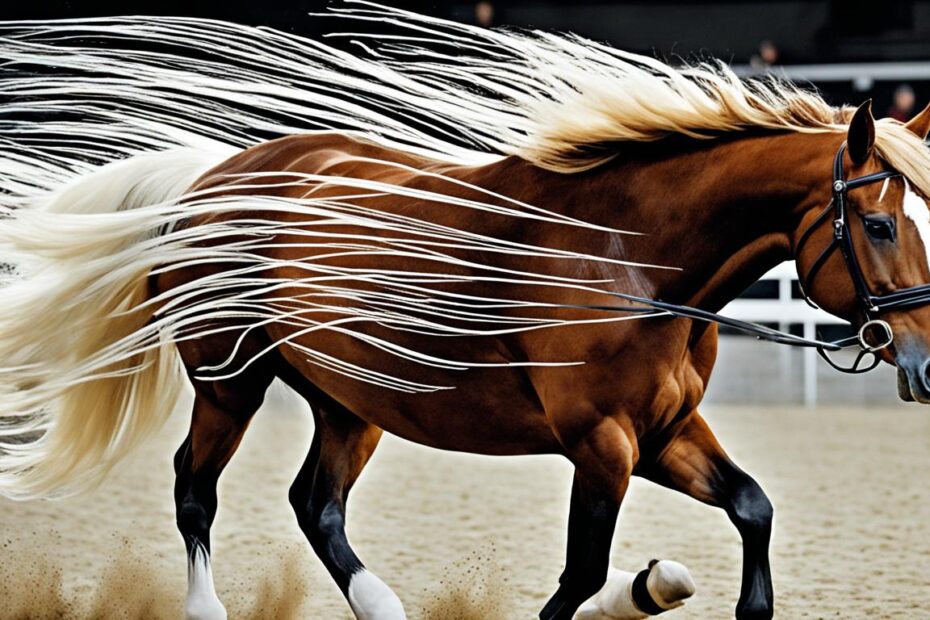In the captivating realm of animal communication, researchers have uncovered a fascinating new approach to understanding and interpreting the non-verbal signals of horses.
This article delves into the development of a groundbreaking Morse code system that harnesses the power of equine tail movements, paving the way for enhanced human-animal interaction and innovative data collection for animal welfare purposes.
Key Takeaways
- Explore the potential of equine tail movements in developing a unique Morse code system
- Gain insights into the significance of horse communication and behavior analysis
- Discover innovative coding techniques that adapt Morse code to equine signaling
- Understand the role of sensor-based equine monitoring in data collection and animal welfare
- Examine the ethical considerations and challenges in implementing this technology
Understanding Equine Communication
Horses are highly expressive animals, and understanding their communication is crucial when developing a Morse code system based on equine tail movements.
Equine communication encompasses a wide range of non-verbal signals, including body posture, facial expressions, and, most notably, tail movements.
Decoding Horse Behavior
Observing and decoding horse behavior is key to interpreting the meaning behind their tail movements. Horses use their tails to convey a wealth of information, from emotional states to social cues.
By understanding the nuances of equine behavior, we can decipher the significance of various tail positions and movements, laying the groundwork for a comprehensive Morse code system.
Significance of Tail Movements
- Tail swishing or flicking can indicate agitation, irritation, or defensive behavior.
- A raised, stiff tail may signal alertness, excitement, or a desire to engage in play or dominance displays.
- A relaxed, loose tail can signify calmness, contentment, or trust in the surrounding environment.
- Tail wringing or tucking can be a sign of fear, anxiety, or submission.
These are just a few examples of the rich tapestry of equine communication through tail movements. By recognizing and interpreting these non-verbal signals, we can gain valuable insights into the equine world and develop more effective means of interacting with and understanding these magnificent animals.
| Tail Movement | Behavioral Interpretation |
|---|---|
| Swishing or Flicking | Agitation, Irritation, Defensive Behavior |
| Raised, Stiff Tail | Alertness, Excitement, Dominance Display |
| Relaxed, Loose Tail | Calmness, Contentment, Trust |
| Wringing or Tucking | Fear, Anxiety, Submission |
Innovative Coding Techniques
As we delve deeper into the fascinating world of equine communication, the need for innovative coding techniques becomes increasingly apparent.
Drawing inspiration from the historical Morse code system, researchers are now exploring ways to adapt and refine this iconic method of transmitting information to accommodate the unique characteristics of equine tail movements.
Adapting Morse Code for Equine Signals
The Morse code, with its distinct dots and dashes, has long been a reliable means of conveying messages. However, the challenge lies in translating this system into a language that horses can effectively communicate.
Through meticulous observation and analysis, scientists are working to develop a robust and intuitive system that can seamlessly bridge the gap between equine behavior and human understanding.
One of the key innovative coding techniques being explored is the mapping of equine tail movements to the Morse code’s familiar patterns.
By closely studying the subtle nuances of how horses use their tails to express themselves, researchers are able to identify distinct patterns that can be directly correlated to the Morse code’s dot-and-dash structure.
This innovative approach not only allows for the accurate translation of equine signals but also paves the way for deeper insights into the complex language of our equine companions.
As the research continues, the potential for this coding system to enhance our understanding and communication with horses grows ever stronger.
Sensor-Based Equine Monitoring
The development of the Morse code system for equine communication relies heavily on the use of sensor-based technologies. These advanced tools play a crucial role in capturing and analyzing the nuances of horses’ non-verbal signaling, particularly their tail movements.
By leveraging sensor-based equine monitoring, researchers can gain unprecedented insights into the intricate language of these majestic animals.
At the heart of this innovative approach are sophisticated sensors that are strategically positioned on the horses’ bodies. These sensors, designed to track the subtle variations in tail positions and movements, collect a wealth of data that can then be processed and interpreted.
Through this sensor-based monitoring, researchers can identify patterns and recognize the underlying meanings of equine tail signals, which are often indicative of the animals’ emotional states, intentions, and even their overall well-being.
The data collected from these sensor-based systems not only supports the development of the Morse code system but also enables a deeper understanding of animal behavior analysis. By decoding the non-verbal signaling of horses, researchers can gain valuable insights into their communication methods, social dynamics, and potential responses to various stimuli.
This knowledge can then be applied to improve animal welfare, enhance training and handling practices, and foster more meaningful interactions between humans and horses.

The deployment of sensor-based equine monitoring represents a significant step forward in the field of animal behavior analysis.
As researchers continue to refine and expand these technologies, we can expect to witness even greater advancements in our understanding of how horses communicate and express themselves through their non-verbal cues.
This knowledge, in turn, will pave the way for more effective and compassionate approaches to equine care and management.
Developing a Morse Code System Based on Equine Tail Movements
In the pursuit of enhancing equine communication, researchers have embarked on a fascinating journey to develop a Morse code system based on the subtle nuances of a horse’s tail movements.
This innovative approach aims to bridge the gap between human understanding and the expressive language of our equine companions.
The process of creating this unique Morse code system involves a deep dive into the fascinating world of horse behavior and the significance of tail movements.
Researchers have meticulously observed and cataloged the various patterns and rhythms exhibited by horses’ tails, carefully decoding the complex messages conveyed through these subtle gestures.
- Identifying Tail Movement Patterns: Researchers have conducted extensive studies to categorize the distinctive tail movements that horses use to communicate. From rapid flicks to gentle swishes, each tail motion carries a specific meaning that provides insights into the horse’s emotional state and intent.
- Mapping Tail Movements to Morse Code: The next step in this pioneering endeavor is the translation of these tail movements into a Morse code-like system. Each unique tail pattern is assigned a corresponding set of dots and dashes, creating a comprehensive language that can be interpreted by both humans and horses.
- Developing Sensor-Based Monitoring: To facilitate the practical application of this Morse code system, researchers are exploring the integration of sensor-based technologies. By incorporating motion sensors and advanced data analysis algorithms, they aim to automate the real-time recognition and interpretation of equine tail movements, enabling seamless communication between humans and horses.
| Tail Movement | Morse Code Equivalent | Meaning |
|---|---|---|
| Rapid Flick | . . | Alert, Cautious |
| Gentle Swish | – | Calm, Relaxed |
| Circular Motion | . – . | Curious, Inquisitive |
The development of this Morse code system based on equine tail movements represents a significant stride in the field of equine communication. By unlocking the hidden language of horses, researchers aim to foster deeper understanding, enhance animal welfare, and ultimately strengthen the bond between humans and their equine companions.
Animal Welfare Data Collection
The Morse code system based on equine tail movements presents exciting opportunities for improved animal welfare data collection.
By harnessing the power of sensor-based equine monitoring, this innovative technology can provide valuable insights into the well-being and behavior of horses, ultimately enhancing our understanding and care for these magnificent creatures.
Ethical Considerations
As we explore the potential of this system, it is crucial to address the ethical considerations surrounding the use of sensor-based monitoring.
While the data collected can greatly benefit animal welfare, we must ensure that the privacy and well-being of the horses are prioritized. Careful implementation and transparent communication with equine owners and caretakers are essential to maintain trust and ethical practices.
Some key ethical considerations include:
- Obtaining informed consent from horse owners and ensuring the system is not intrusive or causing distress to the animals
- Protecting the privacy and confidentiality of the data collected, with robust data management protocols in place
- Utilizing the collected data solely for the purpose of animal welfare enhancement, rather than any unrelated or exploitative applications
- Continuously evaluating the impact of the monitoring system on the horses’ well-being and adjusting as necessary
By addressing these ethical concerns proactively, we can ensure that the Morse code system based on equine tail movements is implemented in a responsible and meaningful way, maximizing its potential to improve animal welfare while maintaining the highest standards of ethical practice.
Gesture Recognition Algorithms
At the heart of the innovative Morse code system for equine communication lie sophisticated gesture recognition algorithms.
These advanced algorithms are designed to precisely interpret the nuanced tail movements of horses, enabling a seamless translation of their behaviors into a universally comprehensible language.
Machine Learning Applications
Underpinning the gesture recognition capabilities are powerful machine learning applications. By feeding the algorithm a vast dataset of equine tail movements and their corresponding behavioral patterns, the system can learn to accurately identify and classify a wide range of equine gestures.
This data-driven approach not only enhances the accuracy of the Morse code translation but also provides valuable insights into animal behavior analysis.
The integration of machine learning techniques allows the system to continuously refine its understanding of equine communication, adapting to the unique characteristics and subtleties of each individual horse.
This dynamic learning process ensures that the Morse code system remains robust and responsive, capable of capturing the full spectrum of equine tail movements and their associated meanings.
| Feature | Description | Benefit |
|---|---|---|
| Gesture Recognition Algorithms | Sophisticated algorithms designed to accurately interpret equine tail movements | Enables precise translation of equine behaviors into a Morse code-based communication system |
| Machine Learning Applications | Leverages vast datasets of equine tail movements and behaviors to continuously refine the system’s understanding | Enhances accuracy and adaptability of the Morse code translation, while also providing valuable insights into animal behavior |
| Animal Behavior Analysis | Data-driven approach allows for in-depth understanding and classification of equine gestures and their associated meanings | Supports advancements in equine welfare and human-animal interaction research |

By leveraging the power of gesture recognition algorithms and machine learning applications, the Morse code system for equine communication represents a transformative step in animal behavior analysis and the enhancement of human-animal interactions.
As the technology continues to evolve, the possibilities for unlocking new insights and fostering deeper connections between humans and horses are truly exciting.
Equestrian Technology Advancements
The development of the Morse code system based on equine tail movements represents a significant advancement in the field of equestrian technology. This innovative approach aligns with and contributes to the broader landscape of technological innovations in the equine industry, from sensor-based monitoring to data-driven decision-making.
Equestrian technology has witnessed remarkable progress in recent years, driven by the integration of cutting-edge sensor-based equine monitoring systems. These advanced systems enable real-time tracking and analysis of a horse’s physiological and behavioral data, providing valuable insights for trainers, veterinarians, and researchers.
Alongside sensor-based monitoring, the equestrian industry has also embraced the power of innovative coding techniques. The adaptation of Morse code to equine signals, as demonstrated in the Morse code system based on tail movements, showcases the industry’s willingness to explore novel and unconventional approaches to communication and data analysis.
These technological advancements have far-reaching implications for the equestrian community. By harnessing the power of sensor-based monitoring and innovative coding techniques, equestrian professionals can gain a deeper understanding of equine behavior, optimize training protocols, and enhance the overall well-being of their equine partners.
As the equestrian industry continues to evolve, the integration of cutting-edge technologies will undoubtedly play a pivotal role in shaping the future of the sport. The Morse code system based on equine tail movements stands as a testament to the industry’s commitment to embracing innovation and driving progress in the realm of equestrian technology.
Human-Animal Interaction
At the heart of the innovative Morse code system based on equine tail movements lies the goal of enhancing communication channels between humans and their equine partners.
This technology holds the potential to strengthen the bond and deepen the understanding between equestrians and their horses, ultimately leading to improved animal welfare and a more enriching human-animal interaction experience.
Enhancing Communication Channels
By decoding the subtle nuances of equine communication, the Morse code system offers a groundbreaking way for equestrians to better interpret their horse’s behavior and respond accordingly. This enhanced communication can lead to a more harmonious partnership, where the needs and preferences of the horse are more readily understood and addressed.
The ability to “listen” to the horse’s tail movements can provide valuable insights into the animal’s emotional state, physical comfort, and overall well-being. This information can empower equestrians to make more informed decisions regarding the horse’s training, care, and overall management, ultimately fostering a stronger, more trusting relationship.
| Aspect | Impact |
|---|---|
| Equine Communication | Improved understanding of horse behavior and emotional states |
| Animal Welfare | Enhanced ability to address the horse’s needs and preferences |
| Human-Animal Interaction | Strengthened bond and trust between equestrians and their horses |
By bridging the communication gap between humans and horses, this innovative Morse code system has the potential to revolutionize the equestrian industry, fostering a deeper appreciation for animal welfare and enriching the overall human-animal interaction experience.
Conclusion
The development of a Morse code system based on equine tail movements represents a groundbreaking approach to horse communication and data collection.
By leveraging the natural behaviors of horses and integrating innovative coding techniques, this system aims to bridge the gap between humans and their equine counterparts, while also contributing to the advancement of equestrian technology and animal welfare research.
Through the analysis of equine communication and the significance of tail movements, this project has paved the way for a deeper understanding of animal behavior.
The integration of sensor-based monitoring and gesture recognition algorithms has enabled the creation of a reliable and efficient Morse code system that can capture valuable data on the well-being and interactions of horses.
As we look to the future, this pioneering work in the field of Developing a Morse Code System Based on Equine Tail Movements holds immense potential. It not only enhances the communication channels between humans and horses but also contributes to the advancement of equestrian technology and the ongoing efforts to prioritize animal welfare.
By continuing to refine and expand this innovative system, we can further strengthen the bond between humans and their equine companions, opening new avenues for collaboration, research, and the betterment of the equestrian industry.
FAQ
What is the Morse code system based on equine tail movements?
The Morse code system based on equine tail movements is an innovative approach to enhancing horse communication and data collection.
This system aims to translate the natural tail movements and non-verbal signals of horses into a language that humans can understand, with the goal of strengthening the bond and interaction between equestrians and their equine partners.
Why is understanding equine communication important for this system?
Understanding the complexities of equine communication is crucial for the development of the Morse code system. By examining the various ways horses convey information through their behavior, particularly the significance of tail movements, the system can be designed to accurately interpret and respond to the horses’ non-verbal signals.
How are the Morse code techniques adapted for equine signals?
Drawing inspiration from the historical Morse code system, the developers have refined and adapted the coding techniques to accommodate the unique characteristics of equine tail movements. This process involves creating a robust and intuitive system that can effectively translate horse behaviors into a language that humans can understand.
What role do sensor-based technologies play in the Morse code system?
Sensor-based technologies are essential for the Morse code system, as they enable the accurate capture and analysis of equine tail movements.
These technologies, combined with data collection methods, are used to monitor the nuances of the horses’ non-verbal signals, providing the foundation for the coding and translation processes.
How does the Morse code system contribute to animal welfare data collection?
Beyond enhancing human-animal interaction, the Morse code system based on equine tail movements presents opportunities for improved animal welfare data collection. By gathering valuable insights into the well-being and behavior of horses, this technology can contribute to a better understanding of equine needs and support efforts to enhance animal welfare.
What are the key considerations in the development of the Morse code system?
The development of the Morse code system based on equine tail movements involves addressing various considerations, including the accuracy of gesture recognition algorithms, the integration of machine learning techniques, and the ethical implications of sensor-based monitoring. These factors are carefully evaluated to ensure the system’s effectiveness and adherence to animal welfare principles.
How does this technology align with advancements in equestrian technology?
The Morse code system based on equine tail movements represents a significant advancement in the field of equestrian technology.
By leveraging innovative coding techniques and sensor-based monitoring, this system contributes to the broader landscape of technological innovations in the equine industry, from data-driven decision-making to enhanced communication and interaction between humans and horses.
What is the impact of the Morse code system on human-animal interaction?
At the core of the Morse code system is the goal of enhancing the communication channels between humans and horses. By strengthening the bond and understanding between equestrians and their equine partners, this technology aims to lead to improved animal welfare and a more enriching human-animal interaction experience.

